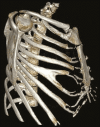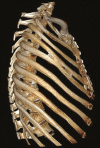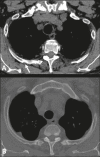Anatomical variations and congenital anomalies of the ribs revisited by multidetector computed tomography
- PMID: 33304010
- PMCID: PMC7720665
- DOI: 10.1590/0100-3984.2019.0131
Anatomical variations and congenital anomalies of the ribs revisited by multidetector computed tomography
Abstract
As they are asymptomatic or have a nonspecific, anatomical variations of the ribs are usually detected as incidental findings on imaging studies. They may be isolated changes or can be related to anomalies or clinical syndromes. Such variations are easily overlooked on conventional radiography and computed tomography if they are not actively investigated, mainly because most indications for a chest X-ray studies aim to evaluate the lung parenchyma and mediastinal structures. The objective of this pictorial essay was to use multislice computed tomography images to illustrate the imaging aspects of the main anatomical variations and congenital anomalies of the ribs.
As variantes anatômicas dos arcos costais são, geralmente, achados incidentais nos exames de imagem, em razão do seu comportamento assintomático ou quadro inespecífico, podendo constituir alterações isoladas ou relacionadas a anomalias e síndromes clínicas. Essas alterações são facilmente negligenciadas na radiografia convencional e na tomografia computadorizada se não forem investigadas ativamente, principalmente quando a maioria das indicações do estudo radiológico do tórax tem como objetivo a avaliação do parênquima pulmonar e das estruturas mediastinais. O objetivo deste artigo é demonstrar, por meio da tomografia computadorizada multidetectores, os aspectos de imagem das principais variantes anatômicas e anomalias congênitas dos arcos costais.
Keywords: Anatomical variation; Multislice computed tomography; Ribs.
Figures










References
-
- Guttentag AR, Salwen JK. Keep your eyes on the ribs: the spectrum of normal variants and diseases that involve the ribs. Radiographics. 1999;19:1125–1142. - PubMed
-
- Glass RBJ, Norton KI, Mitre SA, et al. Pediatric ribs: a spectrum of abnormalities. Radiographics. 2002;22:87–104. - PubMed
-
- Talbot BS, Gange CP Jr, Chaturvedi A, et al. Traumatic rib injury: patterns, imaging pitfalls, complications, and treatment. Radiographics. 2017;37:628–651. - PubMed
-
- Levine BD, Motamedi K, Chow K, et al. CT of rib lesions. AJR Am J Roentgenol. 2009;193:5–13. - PubMed
-
- Ontell FK, Moore EH, Shepard JA, et al. The costal cartilages in health and disease. Radiographics. 1997;17:571–577. - PubMed
LinkOut - more resources
Full Text Sources
Research Materials
